2. 国土资源部古地磁与古构造重点实验室, 北京 100081;
3. 昆明理工大学, 昆明 650093
2. MLR Key Laboratory of Paleomagnetism and Tectonic Reconstruction, Beijing 100081, China;
3. Kunming University of Science and Technology, Kunming 650093, China
华北克拉通自1.85Ga形成之后,经历了广泛的拉伸,形成了一系列中-新元古代裂谷,包括中部的燕辽裂谷,南缘的熊耳裂谷及北缘裂谷(图 1)。其中,北缘裂谷又称为渣尔泰-白云鄂博-化德裂谷,位于华北克拉通北缘,总体呈近东西向展布,记录了华北克拉通与相邻克拉通的拼合、裂解过程(Zhong et al., 2015a; Liu et al., 2014)。同时,该裂谷也是华北克拉通最重要的成矿带之一,其中-新元古代地层中发育一系列大型-超大型多金属矿床,如白云鄂博超大型铁矿-稀土矿、炭窑口大型Zn-Cu-Fe硫化物矿床、东升庙大型铜铅锌矿床、霍各乞大型铜矿、甲生盘铅锌硫矿(Zhai and Santosh, 2013; Peng et al., 2005; Fan et al., 2004,2014; Lai et al., 2015; Zhong et al., 2012,2013,2015b;范宏瑞等,2006; 彭润民等,2007; 陈喜峰,2009)。因此,北缘裂谷的形成、演化过程对认识古大陆演化及指导区域找矿均具有重要意义。但对于该裂谷系中地层的时代始终存在争议,导致对该裂谷的形成及演化过程,仍未取得一致的认识。

|
图 1 华北克拉通中、新元古代地层分布图(据Hu et al., 2014修改) Fig. 1 Distribution of Meso-Neoproterozoic in the North China Craton(modified after Hu et al., 2014) |
北缘裂谷由狼山-渣尔泰山地区渣尔泰群、白云鄂博地区白云鄂博群和化德地区化德群组成,主要为一系列未变质或浅变质的沉积岩组合,包括砂岩、杂砂岩、长石砂岩、泥质岩、钙硅酸盐岩和碳酸盐岩及少量双峰式火山岩等。前人研究认为渣尔泰群、白云鄂博群和化德群形成于古元古代晚期到中元古代早期(Meng et al., 2011)。而最新的测年结果表明:(1)白云鄂博群沉积序列可与燕辽裂谷中、新元古代对比,可划分为中元古代长城系、蓟县系和新元古代青白口系(钟焱,2015);(2)化德群变沉积岩碎屑锆石年龄组成中存在1.33~1.32Ga的年龄峰值(Liu et al., 2014);(3)狼山地区原定为中元古代“渣尔泰群”的地层属于新元古代,应更名为新元古代狼山群(Hu et al., 2014)。但是对于分布于渣尔泰山地区的渣尔泰群,前人研究较少。Li et al.(2007)报道渣尔泰群基性火山岩夹层中16粒锆石的U-Pb年龄为2536~2134Ma,仅1粒锆石的U-Pb年龄为1743Ma,变沉积岩碎屑锆石年龄都分布在2500Ma附近,这个结果与西侧狼山群和北侧白云鄂博群、东侧化德群的年龄分布特征均不同。
本文对渣尔泰山地区的渣尔泰群变沉积岩进行了LA-ICP-MS碎屑锆石U-Pb测年。并综合分析前人对狼山群、白云鄂博群和化德群的研究成果,重新厘定了北缘裂谷的地层格架,为华北克拉通北缘裂谷的形成、演化提供了新的年代学资料。
2 区域地质背景渣尔泰山位于华北克拉通北缘裂谷西南缘。该地区渣尔泰群总体呈近东西向展布,其西侧为狼山群,北侧为白云鄂博群,东侧为化德群,南侧为孔兹岩带。
狼山地区狼山群为一套绿片岩相变质的碎屑岩、碳酸盐岩及少量变火山岩夹层,可分为四个岩组(图 2)。狼山群中酸性变火山岩夹层的锆石U-Pb年龄为816.9±4.5Ma和805.0±5.0Ma(彭润民等,2010; Hu et al., 2014),变沉积岩中碎屑锆石U-Pb年龄最小峰值为810~1187Ma(Hu et al., 2014)。狼山群中发育了炭窑口大型Zn-Cu-Fe硫化物矿床、东升庙大型铜铅锌矿床及霍各乞大型铜矿(Peng et al., 2005,2007; Zhong et al., 2012,2013,2015a)(图 2)。

|
图 2 狼山地区狼山群、渣尔泰山地区渣尔泰群及白云鄂博地区白云鄂博群地层分布图(据内蒙古自治区地质调查院,1982①( ① 内蒙古自治区地质调查院. 1982. 1:20万乌拉特后旗幅、临河县幅、三道桥幅地质图区域地质调查报告),2003②( ② 内蒙古自治区地质调查院. 2003. 1:25万白云鄂博幅地质图区域地质调查报告)) Fig. 2 Distribution of Langshan Group,Zhaertai Group and Bayan Obo Group |
白云鄂博地区白云鄂博群不整合覆盖于太古宙-古元古代基底之上,由浅变质陆源碎屑岩-碳酸盐岩组成,自下而上分为长城系都拉哈拉组和尖山组、蓟县系哈拉霍疙特组和比鲁特组及青白口系白音布拉格组和呼吉尔图组,长城系、蓟县系、青白口系之间均为假整合接触关系(钟焱,2015)。碎屑锆石年龄最小峰值和区域岩浆作用,限定三者的沉积时代分别为1.82~1.65Ga、1.58~1.42Ga和1.23Ga~?(钟焱,2015)。白云鄂博群哈拉霍疙特组中发育了全球最大的稀土-铌-铁矿(章雨旭等,2008)。
化德地区化德群由一套浅变质、未变质沉积岩组成,地层序列包含多个沉积旋回,每个旋回自下而上为含砾砂岩、砂岩、碳酸盐岩和泥质岩。碎屑锆石年龄主要集中在1800±50Ma和1850±50Ma,发育2500Ma和2000Ma的次要峰值。底部变质含砾云母长石石英砂岩中碎屑锆石的最小谐和年龄为1758±7Ma(胡波等,2009)。
孔兹岩带位于华北克拉通西部鄂尔多斯地块北缘,总体呈近东西走向,包括贺兰山杂岩、千里山杂岩、乌拉山-大青山杂岩及集宁杂岩。孔兹岩带主要由典型的孔兹岩系包括高级含石墨石榴矽线泥质片麻岩/麻粒岩、石榴石英岩、长英质副片麻岩、钙质硅酸盐岩和大理岩,以及与孔兹岩相关的TTG片麻岩、镁铁质麻粒岩、同构造紫苏花岗岩和S型花岗岩组成(Dong et al., 2013,2014; Yin et al., 2009,2011)。近年来的锆石SHRIMP和LA-ICP-MS测年结果表明,孔兹岩系原岩沉积时间为2.3~1.95Ga,变质时间为1.95Ga及1.87Ga(Wan et al., 2013; Xia et al., 2006,2008,2009; Dong et al., 2013;Yin et al., 2009,2011),其变质作用表现为顺时针P-T轨迹,记录了约1.95Ga阴山块体与鄂尔多斯地块的碰撞拼合(Zhao et al., 1999,2001,2002,2003a,b,2013)。
3 渣尔泰群地层特征渣尔泰山地区的渣尔泰群不整合覆盖于新太古代色尔腾山群之上,被下二叠统大红山组砾岩不整合覆盖(图 3)。新太古代色尔腾山群主要由云母石英片岩、混合岩及花岗岩组成(Li et al., 2007)。渣尔泰群主要由浅变质沉积岩组成,包括变砾岩、含砾长石石英砂岩、石英岩、白云岩、千枚岩和炭质千枚岩等(Li et al., 2007)。通常,自下而上将渣尔泰群划分为书记沟组、增隆昌组、阿古鲁沟组和刘鸿湾组(图 2、图 3)。
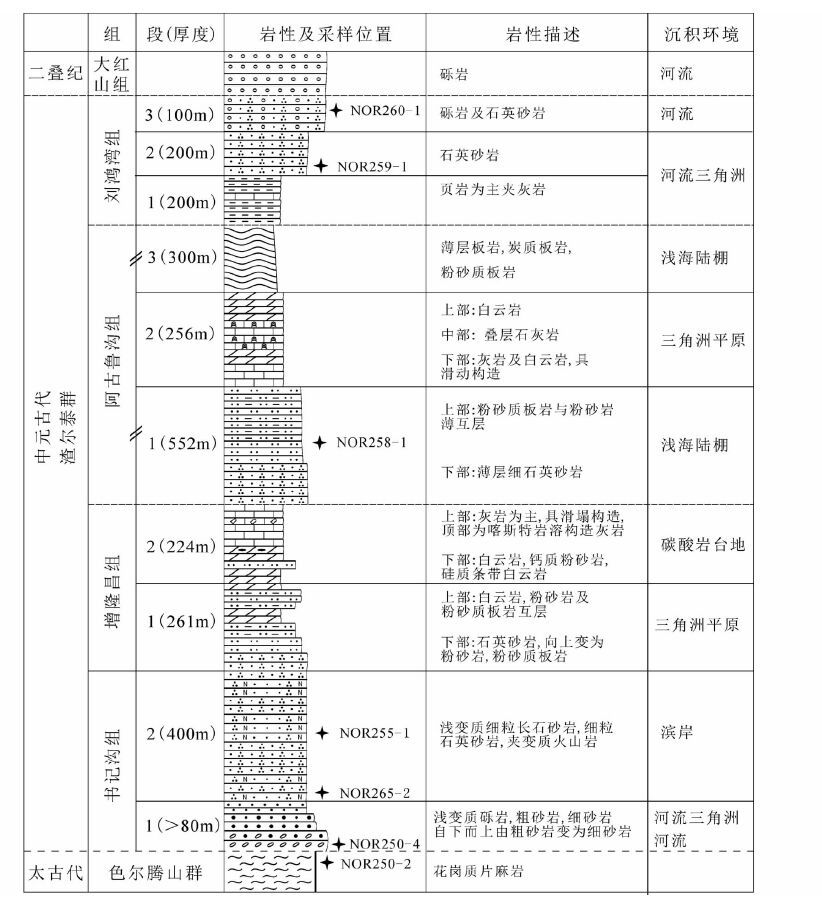
|
图 3 渣尔泰群地层柱状图(据内蒙古自治区地质调查院,2003; 乔秀夫等,1991) Fig. 3 Stratigraphy stratum of the Zhaertai Group(after Qiao et al., 1991) |
书记沟组不整合于下伏太古代色尔腾山群花岗质片麻岩之上,厚度大于1500m,主要为碎屑岩。该组一段底部为砾岩,向上粒度逐渐变细,为粗砂岩、细砂岩、砂岩夹泥岩及粉砂岩,总体为河流-三角洲沉积(图 4a);二段为滨岸变质细粒长石砂岩、变质细粒石英砂岩等(图 4b)。书记沟组中夹变质火山岩及绿帘绿泥黑云母片岩,残留有气孔杏仁构造,经原岩恢复为玄武岩、安山岩粗面岩(Li et al., 2007)。书记沟组被增隆昌组整合覆盖。增隆昌组厚约200m,可分为两个岩性段。一段下部为海岸陆源碎屑沉积,主要为石英砂岩、粉砂岩,上部白云岩与含炭质泥岩、粉砂岩交互出现;二段总体为碳酸盐岩台地沉积(图 4c),下部以白云岩为主夹少量钙质粉砂岩,上部为台地斜坡相藻纹层灰岩,发育滑动构造(图 4d)。增隆昌组被阿古鲁沟组假整合覆盖(乔秀夫等,1991)。阿古鲁沟组厚约1784m,总体为浅海陆棚-碳酸盐岩台地相。该组可分为三个岩性段:一段为具水平层理的薄层状石英砂岩及含炭质粉砂质泥岩;二段为碳酸盐台地结晶灰岩(图 4e)、藻纹层泥晶灰岩(图 4f)、白云岩及叠层石灰岩等;三段为浅海陆棚相薄层状炭质板岩。甲生盘铅锌硫矿产于二岩段顶部白云岩中,其矿源层为二、三岩段白云岩及板岩(郎殿有和张兴俊,1987)。阿古鲁沟组被刘鸿湾组平行不整合覆盖,不整合界面为铁质风化壳(乔秀夫等,1991)。刘鸿湾组厚约3204m,为河流-三角洲沉积,底部为页岩、页岩夹灰岩或灰岩透镜体,中部为纯石英砂岩(图 4g,h),上部为含砾石英砂岩。
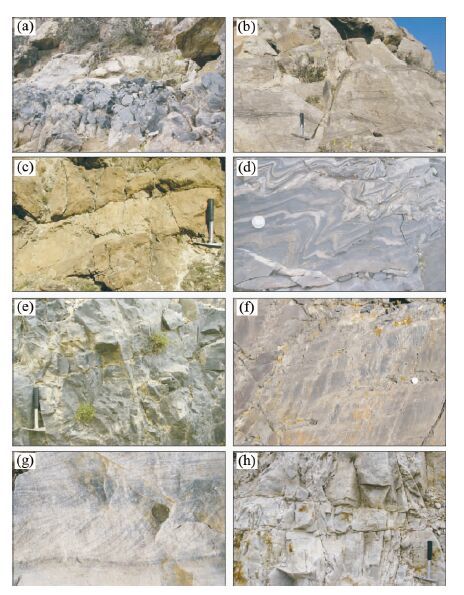
|
图 4 渣尔泰群岩性特征 (a)书记沟组底部变质砾岩;(b)中部具大型板状交错层理的长石石英砂岩;(c)增隆昌组泥晶灰岩;(d)具滑动构造灰岩;(e)阿古鲁沟组深灰色结晶灰岩;(f)藻纹层泥晶灰岩;(g)刘鸿湾组具小型斜层理的石英砂岩;(h)纯石英砂岩 Fig. 4 Sedimentary characteristics of Zhaertai Group (a)meta-conglomerate in the bottom;(b)arkose quartzite with planar cross bedding in the middle part of the Shujigou Formation;(c)micrite;(d)limestone with sliding structure of the Zenglongchang Formation;(e)dark crystalline limestone;(f)laminar algalmicrite of the Agulugou Formation;(g)quartzite sandstone with small oblique bedding of the Liuhongwan Formation;(h)quartzite of the Liuhongwan Formation |
4 分析方法
锆石分选工作在河北省廊坊区域地质调查所实验室完成。将岩石样品粉碎至80目,经过用水粗淘、强磁分选、电磁分选和用酒精细淘之后,在实体显微镜下手工挑选锆石。对挑选出的锆石制作锆石环氧树脂靶,经过打磨和抛光后,拍摄锆石反射光和透射光、阴极发光(CL)图像。
锆石测年在天津地质矿产研究所同位素实验室完成,采用激光多接受器等离子体质谱法(LA-MC-ICP-MS)进行微区原位U-Pb同位素测定。多接收器电感耦合等离子体质谱仪为Thermo Fisher公司制造的Neptune。进样设备激光器为美国ESI公司生产的UP193-FX ArF准分子激光器,激光波长193nm,脉冲宽度5ns,脉冲频率1~200Hz连续可调。利用193nm激光器对锆石进行剥蚀,激光剥蚀的斑束直径为35μm,激光能量密度为10~11J/cm2,频率为8~10Hz,激光剥蚀物质以He为载气送入Neptune的电感耦合等离子体,锆石中的U、Pb在8000℃以上的高温等离子体中发生离子化,利用动态变焦扩大色散可以同时接收质量数相差很大的U-Pb同位素从而进行锆石微区U-Pb同位素原位同时测定。采用TEMORA和GJ-1作为外部锆石年龄标准进行U、Pb同位素分馏校正(Black et al., 2003; Jackson et al., 2004)。采用ICPMSDataCal程序(Liu et al., 2010a,b)和Isoplot程序(Ludwig,2003)进行数据处理,采用208Pb对普通铅进行校正(Andersen,2002)。利用NIST612玻璃标样作为外标计算锆石样品的Pb、U和Th含量。LA-MC-ICP-MS年龄测定实验条件和关键参数:接收器设置:L4,206Pb; L3,207Pb; L2,208Pb; C,219.26; H2,232Th; H4,238U。冷却气体16L/min,辅助气体0.75L/min,Ar载气0.968L/min,He载气0.86L/min。RF功率1251W,积分时间0.131s,样品信号采集时间60s(其中20s为空白测定)。
5 样品及分析结果 5.1 色尔腾山群花岗质片麻岩样品NOR250-2为色尔腾山群花岗质片麻岩,采自渣尔泰群与色尔腾山群的不整合面之下(图 3)。阴极发光图像显示,该样品中的锆石具有环带结构,表明其为岩浆锆石。单粒锆石长约100~150μm,长宽比约2:1~3:1(图 5)。

|
图 5 色尔腾山群花岗质片麻岩(NOR250-2)典型锆石阴极发光图像及测年结果 图中圆圈为激光测试位置,“1(2495)”为“锆石编号(207Pb/206Pb年龄,Ma)”;图 7、图 9同理 Fig. 5 Cathodoluminescence(CL)images and dating results of dated zircons from the granitic geniss(Sample NOR250-2)from Seertengshan Group The circles are the locations of the laser beam,“1(2495)” represents the “grain number(207Pb/206Pb ages,Ma)”; also in the Fig. 7 and Fig. 9 |
对24粒结晶环带清晰的锆石进行了测年分析,结果见附表 1。其中23粒锆石获得了谐和数据(谐和度90%~110%),1粒锆石的谐和度较差。锆石的Th/U比值为0.06~1.09(附表 1),显示岩浆锆石特征。23粒锆石的207Pb/206Pb加权平均年龄为2510±12Ma(1σ,n=23,MSWD=1.9)(图 6)。该年龄代表了色尔腾山群花岗质片麻岩原岩的结晶年龄。
|
|
表 1 渣尔泰山地区色尔腾山群花岗质片麻岩LA-ICP-MS锆石U-Pb分析结果 Table 1 LA-ICP-MS zircon U-Pb dating results of magmatic gneiss from Seertengshan Group in the Zhaertai Shan |
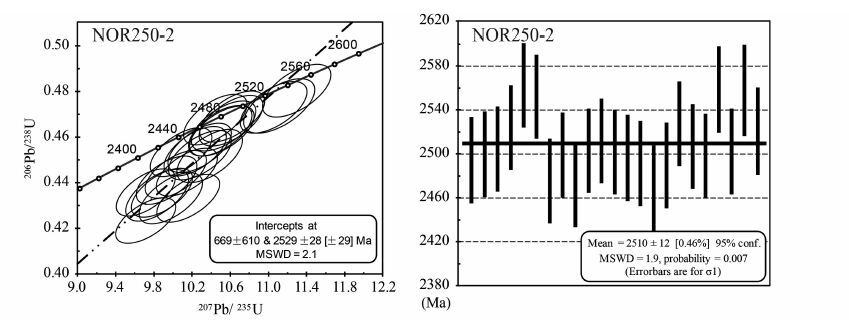
|
图 6 色尔腾山群花岗质片麻岩(NOR250-2)锆石U-Pb测年结果 Fig. 6 Zircon U-Pb condordia diagram for the granitic gneiss(Sample NOR250-2)from the Seertengshan Group |
对书记沟组中的3个变沉积岩样品进行了锆石U-Pb测年。其中样品NOR250-4为采自该组底部变质砾岩中的花岗质片麻岩砾石;而样品NOR255-1和NOR265-2均为石英砂岩,石英含量超过90%。
样品NOR250-4中锆石多具有环带结构,显示岩浆成因特征。锆石的长轴长约100μm,长宽比为1:1~2:1(图 7)。少量锆石发育很窄的变质增生边(如图 7中#4,#10和#16),但难以获得其代表的构造-热事件年龄。选择环带清晰的32粒锆石进行了分析(附表 2)。除1粒锆石的Th/U比值小于0.1之外,其余31粒锆石的Th/U比值为0.21~1.45,具岩浆成因锆石特征。其中31粒锆石的谐和度较好,其207Pb/206Pb年龄集中于2468~2545Ma,对其进行加权平均,获得了2510±7Ma(1σ,n=31,MSWD=1.0)的年龄(图 8)。
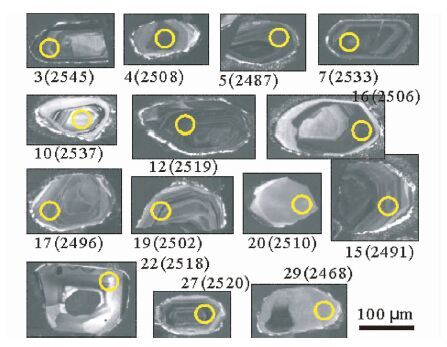
|
图 7 渣尔泰群书记沟组变砾岩花岗质片麻岩砾石(NOR250-4)中锆石阴极发光图像及测年结果 Fig. 7 Cathodoluminescence(CL)images and dating results of typical dated zircons from granitic gravel(Sample NOR250-4)from metamorphic conglomerate in the Shujigou Formation,Zhaertai Group |
|
|
表 2 渣尔泰群书记沟组变砾岩中花岗质片麻岩砾石LA-ICP-MS锆石U-Pb分析结果 Table 2 LA-ICP-MS zircon U-Pb dating results of granitic gneiss conglomerate from Shujigou Formation meta-conglomerate,Zhaertai Group |

|
图 8 渣尔泰群书记沟组变砾岩花岗质片麻岩砾石(NOR250-4)LA-ICP-MS锆石U-Pb测年结果 Fig. 8 LA-ICP-MS zircon U-Pb dating results of granitic gravel(Sample NOR250-4)from metamorphic conglomerate in the Shujigou Formation,Zhaertai Group |
样品NOR265-2中分选出的锆石外形多呈椭圆状,显示经过了搬运磨圆,大多数锆石直径为80~100μm。锆石内部具明显的环带结构,少数锆石发育很窄的增生边(图 9)。对104粒随机选择的锆石进行了分析(附表 3)。锆石的Th/U比值为0.06~1.91。其中101粒锆石的207Pb/206Pb年龄谐和度较好,年龄最小值为2393Ma,最大为2558Ma,峰值年龄为2500Ma(图 10)。样品NOR255-1中所分选出的锆石多呈椭圆状,显示经过搬运磨圆的特征,大多数锆石直径为80~100μm,少数直径可达200μm,锆石长轴与短轴之比为1:1。锆石内部具明显的环带结构,未见明显的增生边(图 9)。随机选择100粒锆石进行U-Pb同位素分析(附表 3)。其Th/U比值约为0.05~1.95,其中大部分锆石的Th/U比值大于0.1,仅7颗锆石的Th/U比值小于0.1。97粒锆石获得了谐和年龄,其中207Pb/206Pb年龄最小为1732Ma,最大为2709Ma,峰值为1920Ma和2520Ma(图 10)。
|
|
表 3 渣尔泰群书记沟组变沉积岩LA-ICP-MS锆石U-Pb分析结果 Table 3 LA-ICP-MS zircon U-Pb dating results of meta-sedimentary rocks from Shujigou Formation,Zhaertai Group |

|
图 9 渣尔泰群变沉积岩典型碎屑锆石阴极发光图像及测年结果 样品NOR255-1与NOR265-2采自书记沟组,NOR258-1采自阿古鲁沟组,NOR259-1与NOR265-2采自刘鸿湾组 Fig. 9 Cathodoluminescence(CL)images and dating results of typical dated zircons from metasedimentary rocks of Zhaertai Group Sample NOR255-1 and NOR265-2 are collected from Shujigou Formation. Sample NOR258-1 is collected from Agulugou Formation. Sample NOR259-1 and NOR265-2 are collected from Liuhongwan Formation |

|
图 10 渣尔泰群书记沟组变沉积岩LA-ICP-MS碎屑锆石U-Pb测年结果 Fig. 10 U-Pb Concordia diagrams and 207Pb/206Pb age histograms of the detrital zircon samples from Shujigou Formation,Zhaertai Group |
在阿古鲁沟组中采集了1个样品(NOR258-1)进行了锆石U-Pb年代学分析。该样品为粉砂质板岩,采自阿古鲁沟组中部。样品中的锆石大多呈短柱状,直径为80~100μm,长宽比为1:1~2:1。部分锆石具有一定的磨圆。锆石内部环带清晰,少量锆石具有变质增生边(图 9)。随机选择了96粒锆石进行了U-Pb同位素分析(附表 4)。锆石的Th/U比值为0.03~2.06(附表 4)。其中94粒锆石获得了谐和年龄,其207Pb/206Pb年龄最小为1767Ma,最大为2987Ma,在年龄直方图上显示出1900Ma和2500Ma两个明显的峰值(图 11)。
|
|
表 4 渣尔泰群阿古鲁沟变沉积岩LA-ICP-MS锆石U-Pb分析结果 Table 4 LA-ICP-MS zircon U-Pb dating results of meta-sedimentary rocks from Agulugou Formation,Zhaertai Group |
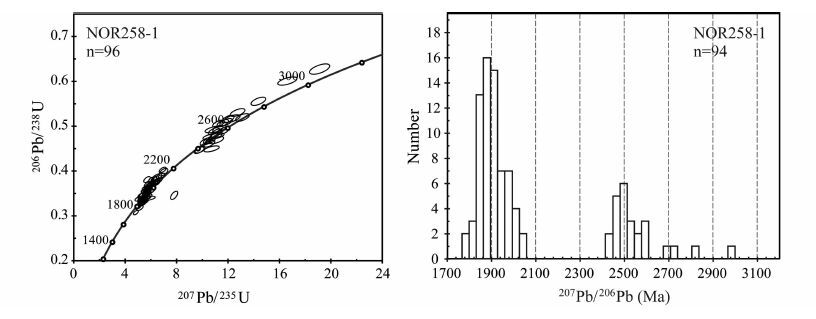
|
图 11 渣尔泰群阿古鲁沟组变沉积岩LA-ICP-MS碎屑锆石U-Pb测年结果 Fig. 11 U-Pb Concordia diagrams and 207Pb/206Pb age histograms of the detrital zircon samples from Agulugou Formation,Zhaertai Group |
对刘鸿湾组中2个变沉积岩样品进行了锆石U-Pb测年分析。其中样品NOR259-1为变质砂岩,采自刘鸿湾组中部。样品中分选出的锆石表现为浑圆状与短柱状两种不同形态。其中浑圆状锆石中结晶环带不清楚,且多具有核幔构造。而短柱状锆石中可见较明显的结晶环带,大多数不发育增生边,少量具有很窄的增生边(图 9)。随机选择了96粒锆石进行测试(附表 5),获得Th/U比值为0.03~1.70。其中93粒锆石得到了谐和年龄,207Pb/206Pb年龄最小为1838Ma,最大为2511Ma。锆石的峰值年龄为1940Ma,次级峰值为2130Ma和2470Ma(图 12)。所测试的锆石中,有2粒锆石具有明显的核幔结构,对其分别进行了分析。其中1粒锆石的核部(#5)与边部(#6)分别获得了1898±21Ma和1864±21Ma的年龄。另1粒锆石的核部(#91)与边部(#92)分别得到了2025±21Ma和1940±21Ma的年龄(图 12)。
|
|
表 5 渣尔泰群刘鸿湾组变沉积岩LA-ICP-MS锆石U-Pb分析结果 Table 5 LA-ICP-MS zircon U-Pb dating results of meta-sedimentary rocks from Liuhongwan Formation,Zhaertai Group |

|
图 12 渣尔泰群刘鸿湾组变沉积岩LA-ICP-MS碎屑锆石U-Pb测年结果 Fig. 12 U-Pb Concordia diagrams and 207Pb/206Pb age histograms of the detrital zircon samples from Liuhongwan Formation,Zhaertai Group |
样品NOR260-1为刘鸿湾组上部的石英片岩,石英含量大于90%。该样品中的锆石多为短柱状,颗粒较小,粒径约50μm,锆石多具明显的结晶环带,少数锆石具有很窄的增生边(图 9)。对随机选择的96粒锆石进行了分析(附表 5),其Th/U比值为0.06~1.83。所分析的锆石中,仅53粒锆石的年龄谐和度较好(90%~110%),最小207Pb/206Pb年龄为1746Ma,最大为2650Ma。主峰值年龄为1860Ma,次级峰值为2160Ma和2500Ma(图 12)。
6 讨论 6.1 渣尔泰群的时代
从碎屑锆石年龄组成特征来看,渣尔泰群的碎屑锆石年龄主要集中于1.8~1.9Ga和2.5Ga(图 13a)。结合Li et al.(2007)获得的书记沟组基性火山岩夹层中1粒锆石1743±7Ma的U-Pb年龄,可以限定渣尔泰群的最大沉积时限小于1.8~1.9Ga。
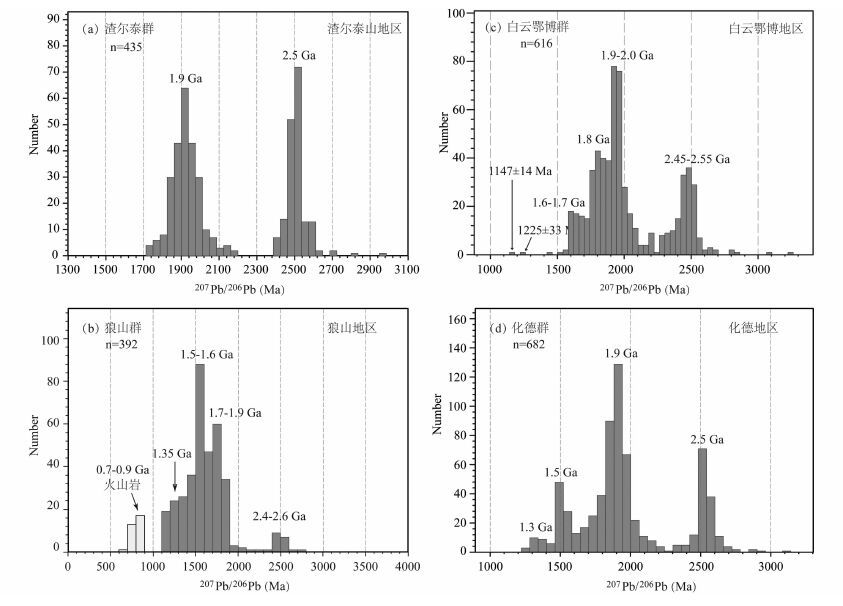
|
图 13 渣尔泰群、狼山群、白云鄂博群、化德群变沉积岩碎屑锆石年龄组成对比 (a)渣尔泰群碎屑锆石年龄组成;(b)狼山群碎屑锆石年龄组成(数据引自Hu et al., 2014);(c)白云鄂博群碎屑锆石年龄组成(数据引自Zhong et al., 2015b; 钟焱,2015);(d)化德群碎屑锆石年龄组成(数据胡波等,2009; Liu et al., 2014) Fig. 13 Comparison of detrital zircon U-Pb ages from different stratums (a)Zhaertai Group;(b)Langshan Group(data from Hu et al., 2014);(c)Bayan Obo Group(data from Zhong et al., 2015b; Zhong,2015);(d)Huade Group(data from Hu et al., 2009; Liu et al., 2014) |
前人大量的锆石年代学测试结果表明,北缘裂谷带中对应于燕辽裂谷长城系的地层,碎屑锆石年龄组成具有明显的特征,主要出现1.9Ga和2.5Ga两个峰值,如白云鄂博群长城系都拉哈拉组与尖山组(Zhong et al., 2015a; 钟焱,2015)和化德群下部地层(Liu et al., 2014)。而更新的地层中,则出现了年轻的碎屑锆石,如白云鄂博群蓟县系哈拉霍疙特组碎屑锆石组成了1.65Ga和2.2~2.3Ga的年龄峰值(图 13c),青白口系白音布拉格组主要年龄峰值为1.8Ga和2.5Ga,还有1147±14Ma和1225±33Ma的2粒锆石(钟焱,2015),而化德群上部地层中则出现了1.3Ga、1.5Ga、1.7~1.8Ga和2.5Ga等峰值,可能对应于燕辽裂谷中的待建系(Liu et al., 2014),新元古代狼山群浅变质沉积岩的碎屑锆石年龄组成了1.1~1.35Ga、1.5~1.6Ga、1.8Ga和2.5Ga等主要峰值(Hu et al., 2014)。渣尔泰山地区渣尔泰群的碎屑锆石年龄组成与北缘裂谷中相当于长城系地层的碎屑锆石年龄组成一致,而与较新地层的碎屑锆石年龄组成差别较大。因此,渣尔泰山地区的渣尔泰群可与长城系对比,属于中元古代早期沉积。
6.2 渣尔泰群的物源渣尔泰群碎屑物质主要来自华北克拉通内部。渣尔泰群碎屑锆石年龄组成主要表现为2.5Ga和1.8~1.9Ga两个峰值。其中继承性碎屑锆石Th/U比值普遍偏高,并具有典型的岩浆结晶环带,表明其寄主岩石的物质来源主要为岩浆岩。渣尔泰群底部书记沟组不整合于太古宙色尔腾山群之上。书记沟组底部变质砾岩中花岗质片麻岩砾石的锆石207Pb/206Pb年龄为2510±7Ma(图 8),下伏色尔腾山群花岗质片麻岩的锆石207Pb/206Pb年龄为2510±12Ma(图 6)。二者年龄一致,表明书记沟组底部砾岩中的砾石来自渣尔泰山地区太古宙色尔腾山群。书记沟组砾岩之上的石英砂岩,除1粒锆石的207Pb/206Pb年龄为2393±19Ma外,其余碎屑锆石年龄集中于2435~2558Ma,峰值年龄为2.5Ga,书记沟组沉积早期,锆石年龄组成较单一,表明沉积初始阶段,物质来源较单一,是近源快速堆积的产物;向上的石英砂岩样品中,除峰值年龄为2.5Ga的锆石外,出现了大量峰值年龄为1.8~1.9Ga的碎屑锆石,表明其物源更加复杂。除书记沟组之外,阿古鲁沟组和刘鸿湾组中也存在明显的2.5Ga的年龄峰值。从区域上来看,渣尔泰群中2.5Ga的碎屑物质主要来自相邻的孔兹岩带,如大青山地区、乌拉山地区及贺兰山地区2.5~2.45Ga的古元古代表壳岩(吴昌华等,2006; 周喜文和耿元生,2009; Dong et al., 2013; 蔡佳等,2015)、固阳杂岩中2.56~2.5Ga的闪长岩、花岗岩体(简平等,2005; Jian et al., 2012)以及大量的花岗质片麻岩(Peng et al., 2010,2011)。在阿古鲁沟组和刘鸿湾组中,年轻的锆石逐渐增加,显示出了1.8~1.9Ga的较强峰值。1.8~2.1Ga孔兹岩带发生了强烈的构造-岩浆作用及构造-热事件(Yin et al., 2009,2011; Wan et al., 2013; 周喜文和耿元生,2009; 蔡佳等,2015)。因此,渣尔泰群中1.8~1.9Ga峰值的碎屑锆石,同样来自于孔兹岩带。
6.3 北缘裂谷演化过程沉积地层及岩浆岩的年代学研究表明,华北克拉通北缘裂谷是中-新元古代多期裂解事件形成的复杂裂谷,经历了长期复杂的演化过程(翟明国等,2004; Zhai et al., 2015)。主要可分为以下3个阶段:
中元古代早-中期:主要表现为拉张环境下形成的沉积地层及岩浆岩。在渣尔泰山地区沉积了渣尔泰群,拉张作用导致了书记沟组1.75Ga玄武岩的形成(Li et al., 2007)。在白云鄂博地区,沉积了白云鄂博群长城系都拉哈拉组和尖山组,其沉积时代为1.82~1.65Ga,并发育了锆石U-Pb年龄为1728±5Ma的玄武岩(Lu et al., 2002,2008),及蓟县系哈拉霍疙特组和比鲁特组,其沉积时代为1.58~1.42Ga;以及化德地区的化德群下部的毛忽庆组、头道河组、朝阳河组、比鲁特组和葛家营组,相当于燕辽裂谷中元古代长城系和蓟县系,其中缺乏火山岩,碎屑锆石年龄组成1850Ma和2500Ma的峰值(胡波等,2009;Liu et al., 2014),与燕辽裂谷中长城系、蓟县系的碎屑锆石年龄组成相似(Wan et al., 2003,2011),应为相同时代地层。前人研究表明,中元古代北缘裂谷、燕辽裂谷及相应的岩浆事件是哥伦比亚超大陆裂解过程在华北克拉通的响应(Zhao et al., 2004; Peng et al., 2007; Zhai et al., 2011; 刘超辉和刘福来,2015)。因此,北缘裂谷中元古代早-中期裂解事件可能反映了哥伦比亚超大陆裂解早期的陆内伸展。
中元古代中-晚期:该期裂解事件在渣尔泰山地区没有相应的记录。在白云鄂博地区主要表现为裂谷相关的1.4~1.3Ga的碳酸岩墙(任英忱等,1994; 张宗清等,2003; Fan et al., 2006,2014; Yang et al., 2011a)和1.23Ga的镁铁质岩墙(Yang et al., 2011b)。在化德地区沉积了化德群上部的三夏天组,2个样品的最小碎屑锆石年龄的加权平均值分别为1333±17Ma和1368±31Ma,而呼吉尔图组中,最小碎屑锆石年龄的加权平均值为1337±7Ma(Liu et al., 2014),而这两套地层又被约1320Ma的A型花岗岩侵位(Zhang et al., 2012; Shi et al., 2012),因此可以限定其沉积时代为1.34~1.32Ga(Liu et al., 2014),相当于燕辽裂谷系中元古代待建系下马岭组之上地层(图 14)。北缘裂谷中元古代晚期裂解事件与哥伦比亚超大陆最终破裂的时间一致,这表明华北克拉通也参与到了1.35~1.20Ga哥伦比亚超大陆的最终破裂过程(Zhong et al., 2015a; 钟焱,2015; Liu et al., 2014)。

|
图 14 华北克拉通北缘裂谷地层格架 Fig. 14 Correlation of Zhaertai Group,Bayan Obo Group,Huade Group in the North Margin Rift Zone and Meso-Neoproterozoic in the Yanliao rift of North China Craton |
新元古代:主要表现为狼山地区新元古代狼山群。碎屑锆石年龄峰值主要为1.35Ga、1.5~1.6Ga、1.7~1.8Ga及2.4~2.6Ga,最小碎屑锆石年龄限定狼山群沉积时代主体应该小于1100Ma,最新沉积地层时代小于810Ma(Hu et al., 2014)。此外,狼山群二岩组中发育了U-Pb年龄为0.8Ga的变火山岩夹层(彭润民等,2010; Hu et al., 2014),地球化学特征表明其形成于张性裂谷盆地中(彭润民等,2010)。钟焱(2015)提出白云鄂博地区白云鄂博群上部白音宝拉格组和呼吉尔图组对应于新元古界青白口系,也记录了该期裂解事件。从时间上来看,北缘裂谷新元古代裂解事件很可能与Rodinia超大陆裂解相关(Li et al., 1996; Rogers and Santosh, 2003; 彭澎等,2002; Zhai et al., 2003,2015; 彭润民等,2010)。
7 结论(1) 锆石测年结果及区域地层对比表明,渣尔泰群属于中元古代早期沉积,对应于燕辽裂谷中的长城系。
(2) 渣尔泰群的碎屑锆石年龄峰值主要为2.5Ga和1.8~1.9Ga,其碎屑物质主要来自于华北克拉通内部。
(3) 华北克拉通北缘裂谷为中-新元古代长期发育的裂谷,渣尔泰群、白云鄂博群下部及化德群下部地层为中元古代早-中期裂谷沉积,白云鄂博群中部及化德群上部为裂谷中-晚期沉积,狼山群及白云鄂博群上部为新元古代裂谷晚期沉积。
致谢 感谢天津地质矿产研究所同位素实验室的耿建珍和李国占在锆石测年过程中给予的帮助;感谢两位审稿人及编辑提出的宝贵意见。
| [1] | Andersen T. 2002. Correction of common lead in U-Pb analyses that do not report 204Pb. Chemical Geology, 192(1-2): 59-79 |
| [2] | Black LP, Kamo SL, Allen CM, Aleinikoff JN, Davis DW, Kosch RJ and Foudoulis C. 2003. TEMORA 1: A new zircon standard for Phanerozoic U-Pb geochronology. Chemical Geology, 200(1-2): 155-170 |
| [3] | Cai J, Liu FL, Liu PH, Wang F and Shi JR. 2015. Geochronology of the Paleoproterozoic khondalite rocks from the Wulashan-Daqingshan area, the Khondalite Belt. Acta Petrologica Sinica, 31(10): 3081-3106 (in Chinese with English abstract) |
| [4] | Chen XF. 2009. Studying the characteristics of Fe-Cu-Pb-Zn polymetallic sulfide deposit in Langshan-Zha'ertaishan metallogenic belt. Mineral Resources and Geology, 23(4): 291-296 (in Chinese with English abstract) |
| [5] | Dong CY, Wan YS, Xu ZY, Liu DY, Yang ZS, Ma MZ and Xie HQ. 2013. SHRIMP zircon U-Pb dating of Late Paleoproterozoic kondalites in the Daqing Mountains area on the North China Craton. Science China (Earth Sciences), 56(1): 115-125 |
| [6] | Dong CY, Wan YS, Wilde SA, Xu ZY, Ma MZ, Xie HQ and Liu DY. 2014. Earliest Paleoproterozoic supracrustal rocks in the North China Craton recognized from the Daqingshan area of the Khondalite Belt: Constraints on craton evolution. Gondwana Research, 25(4): 1535-1553 |
| [7] | Fan HR, Xie YH, Wang KY, Tao KJ and Wilde SA. 2004. REE daughter minerals trapped in fluid inclusions in the giant Bayan Obo REE-Nb-Fe deposit, Inner Mongolia, China. International Geology Review, 46(7): 638-645 |
| [8] | Fan HR, Hu FF, Chen FK, Yang KF and Wang KY. 2006. Intrusive age of No.1 carbonatite dyke from Bayan Obo REE-Nb-Fe deposit, Inner Mongolia: With answers to comment of Dr. Le Bas. Acta Petrologica Sinica, 22(2): 519-520 (in Chinese with English abstract) |
| [9] | Fan HR, Hu FF, Yang KF, Pirajno F, Liu X and Wang KY. 2014. Integrated U-Pb and Sm-Nd geochronology for a REE-rich carbonatite dyke at the giant Bayan Obo REE deposit, northern China. Ore Geology Reviews, 63: 510-519 |
| [10] | Hu B, Zhai MG and Guo JH. 2009. LA-ICP-MS U-Pb geochronology of detrital zircons from the Huade Group in the northern margin of the North China Craton and its tectonic significance. Acta Petrologica Sinica, 25(1): 193-211 (in Chinese with English abstract) |
| [11] | Hu JM, Gong WB, Wu SJ, Liu Y and Liu SC. 2014. LA-ICP-MS zircon U-Pb dating of the Langshan Group in the northeast margin of the Alxa block, with tectonic implications. Precambrian Research, 255: 756-770 |
| [12] | Jackson SE, Pearson NJ, Griffin WL and Belousova EA. 2004. The application of laser ablation-inductively coupled plasma-mass spectrometry to in situ U-Pb zircon geochronology. Chemical Geology, 211(1-2): 47-69 |
| [13] | Jian P, Zhang Q, Liu DY, Jin WJ, Jia XQ and Qian Q. 2005. SHRIMP dating and geological significance of Late Achaean high-Mg diorite (sanukite) and hornblende-granite at Guyang of Inner Mongolia. Acta Petrologica Sinica, 21(1): 151-157 (in Chinese with English abstract) |
| [14] | Jian P, Kröner A, Windley BF, Zhang Q, Zhang W and Zhang LQ. 2012. Episodic mantle melting-crustal reworking in the late Neoarchean of the northwestern North China Craton: Zircon ages of magmatic and metamorphic rocks from the Yinshan Block. Precambrian Research, 222-223: 230-254 |
| [15] | Lai XD, Yang XY, Santosh M, Liu YL and Ling MX. 2015. New data of the Bayan Obo Fe-REE-Nb deposit, Inner Mongolia: Implications for ore genesis. Precambrian Research, 263: 108-122 |
| [16] | Lang DY and Zhang XJ. 1987. Geological setting and genesis of the Jiashengpan Pb-Zn-S Ore belt, Inner Mongolia. Mineral Deposits, 6(2): 39-54 (in Chinese with English abstract) |
| [17] | Li QL, Chen FK, Guo JH, Li XH, Yang YH and Siebel W. 2007. Zircon ages and Nd-Hf isotopic composition of the Zhaertai Group (Inner Mongolia): Evidence for Early Proterozoic evolution of the northern North China Craton. Journal of Asian Earth Sciences, 30(3-4): 573-590 |
| [18] | Li ZX, Zhang L and Powell CM. 1996. Positions of the East Asian cratons in the Neoproterozoic supercontinent Rodinia. Australian Journal of Earth Sciences, 43(6): 593-604 |
| [19] | Liu CH, Zhao GC and Liu FL. 2014. Detrital zircon U-Pb, Hf isotopes, detrital rutile and whole-rock geochemistry of the Huade Group on the northern margin of the North China Craton: Implications on the breakup of the Columbia supercontinent. Precambrian Research, 254: 290-305 |
| [20] | Liu CH and Liu FL. 2015. The Mesoproterozoic rifting in the North China Craton: A case study for magmatism and sedimentation of the Zhaertai-Bayan Obo-Huade rift zone. Acta Petrologica Sinica, 31(10): 3107-3128 (in Chinese with English abstract) |
| [21] | Liu YS, Gao S, Hu ZC, Gao CG, Zong KQ and Wang DB. 2010a. Continental and oceanic crust recycling-induced melt-peridotite interactions in the Trans-North China Orogen: U-Pb dating, Hf isotopes and trace elements in zircons from mantle xenoliths. Journal of Petrology, 51(1-2): 537-571 |
| [22] | Liu YS, Hu ZC, Zong KQ, Gao CG, Gao S, Xu J and Chen HH. 2010b. Reappraisement and refinement of zircon U-Pb isotope and trace element analyses by LA-ICP-MS. Chinese Science Bulletin, 55(15): 1535-1546 |
| [23] | Lu SN, Yang CL, Li HK and Li HM. 2002. A group of rifting events in the terminal Paleoproterozoic in the North China Craton. Gondwana Research, 5(1): 123-131 |
| [24] | Lu SN, Zhao GC, Wang HC and Hao GJ. 2008. Precambrian metamorphic basement and sedimentary cover of the North China Craton: A review. Precambrian Research, 160(1-2): 77-93 |
| [25] | Ludwig KR. 2003. User's manual for Isoplot/Ex, version 3.00: A geochronological toolkit for Microsoft excel. Berkeley: Berkeley Geochronology Center Special Publication, 4: 1-70 |
| [26] | Meng QR, Wei HH, Qu YQ and Ma SX. 2011. Stratigraphic and sedimentary records of the rift to drift evolution of the northern North China Craton at the Paleo- to Mesoproterozoic transition. Gondwana Research, 20(1): 205-218 |
| [27] | Peng P, Liu WJ and Zhai MG. 2002. Response of North China Block to Rodinia supercontinent and its characteristics. Acta Petrologica et Mineralogica, 21(4): 343-355 (in Chinese with English abstract) |
| [28] | Peng P, Zhai MG, Guo JH, Kusky T and Zhao TP. 2007. Nature of mantle source contributions and crystal differentiation in the petrogenesis of the 1.78Ga mafic dykes in the central North China Craton. Gondwana Research, 12(1-2): 29-46 |
| [29] | Peng P, Guo JH, Zhai MG and Bleeker W. 2010. Paleoproterozoic gabbronoritic and granitic magmatism in the northern margin of the North China Craton: Evidence of crust-mantle interaction. Precambrian Research, 183(3): 635-659 |
| [30] | Peng P, Guo JH, Windley BF and Li XH. 2011. Halaqin volcano-sedimentary succession in the central-northern margin of the North China Craton: Products of Late Paleoproterozoic ridge subduction. Precambrian Research, 187(1-2): 165-180 |
| [31] | Peng RM, Zhai YS, Wang ZG and Han XF. 2005. Discovery of double-peaking potassic volcanic rocks in Langshan Group of the Tanyaokou hydrothermal-sedimentary deposit, Inner Mongolia, and its indicating significance, Science in China (Series D), 48(6): 822-833 |
| [32] | Peng RM, Zhai YS, Hang XF, Wang ZG, Wang JP, Shen CL and Chen XF. 2007. Mineralization response to the structural evolution in the Langshan orogenic belt, Inner Mongolia. Acta Petrologica Sinica, 23(3): 679-688 (in Chinese with English abstract) |
| [33] | Peng RM, Zhai YS, Wang JP, Chen XF, Liu Q, Lü JY, Shi YX, Wang G, Li SB, Wang LG, Ma YT and Zhang P. 2010. Discovery of Neoproterozoic acid volcanic rock in the western section of Langshan, Inner Mongolia, and its geological significance. Chinese Science Bulletin, 55(26): 2611-2620 (in Chinese) |
| [34] | Qiao XF, Yao PY, Wang CS, Tan L, Zhu SY, Zhou SD and Zhang YQ. 1991. Sequence stratigraphy and tectonic environment of the Chartai Group, Inner Mongolia. Acta Geologica Sinica, (1): 1-15 (in Chinese with English abstract) |
| [35] | Ren YC, Zhang YC and Zhang ZQ. 1994. Study on heat events of ore-forming Bayan Obo deposit. Acta Geoscientica Sinica, (1-2): 95-101 (in Chinese with English abstract) |
| [36] | Rogers JJW and Santosh M. 2003. Supercontinents in earth history. Gondwana Research, 6(3): 357-368 |
| [37] | Shi YR, Liu DY, Kröner A, Jian P, Miao LC and Zhang FQ. 2012. Ca. 1318Ma A-type granite on the northern margin of the North China Craton: Implications for intraplate extension of the Columbia supercontinent. Lithos, 148: 1-9 |
| [38] | Wan YS, Zhang QD and Song TR. 2003. SHRIMP ages of detrital zircons from the Changcheng system in the Ming Tombs area, Beijing: Constraints on the protolith nature and maximum depositional age of the Mesoproterozoic cover of the North China Craton. Chinese Science Bulletin, 48(22): 2500-2506 |
| [39] | Wan YS, Liu DY, Wang W, Song TR, Kröner A, Dong CY, Zhou HY and Yin XY. 2011. Provenance of Meso- to Neoproterozoic cover sediments at the Ming Tombs, Beijing, North China Craton: An integrated study of U-Pb dating and Hf isotopic measurement of detrital zircons and whole-rock geochemistry. Gondwana Research, 20(1): 219-242 |
| [40] | Wan YS, Xu ZY, Dong CY, Nutman A, Ma MZ, Xie HQ, Liu SJ, Liu DY, Wang HC and Cu H. 2013. Episodic Paleoproterozoic (-2.45, -1.95 and -1.85Ga) mafic magmatism and associated high temperature metamorphism in the Daqingshan area, North China Craton: SHRIMP zircon U-Pb dating and whole-rock geochemistry. Precambrian Research, 224: 71-93 |
| [41] | Wu CH, Sun M, Li HM, Zhao GC and Xia XP. 2006. LA-ICP-MS U-Pb zircon ages of the khondalites from the Wulashan and Jining high-grade terrain in northern margin of the North China Craton: Constraints on sedimentary age of the khondalite. Acta Petrologica Sinica, 22(11): 2639-2654 (in Chinese with English abstract) |
| [42] | Xia XP, Sun M, Zhao GC, Wu FY, Xu P, Zhang JH and Luo Y. 2006. U-Pb and Hf isotopic study of detrital zircons from the Wulashan khondalites: Constraints on the evolution of the Ordos Terrane, Western Block of the North China Craton. Earth and Planetary Science Letters, 241(3-4): 581-593 |
| [43] | Xia XP, Sun M, Zhao GC, Wu FY, Xu P, Zhang JS and He YH. 2008. Paleoproterozoic crustal growth in the Western Block of the North China Craton: Evidence from detrital zircon Hf and whole rock Sr-Nd isotopic compositions of the Khondalites from the Jining Complex. American Journal of Science, 308(3): 304-327 |
| [44] | Xia XP, Sun M, Zhao GC, Wu FY, Xu P and Zhang JS. 2009. Detrital zircon U-Pb age and Hf isotope study of the khondalite in Trans-North China Orogen and its tectonic significance. Geological Magazine, 146: 701-716 |
| [45] | Yang KF, Fan HR, Santosh M, Hu FF and Wang KY. 2011a. Mesoproterozoic mafic and carbonatitic dykes from the northern margin of the North China Craton: Implications for the final breakup of Columbia supercontinent. Tectonophysics, 498(1-4): 1-10 |
| [46] | Yang KF, Fan HR, Santosh M, Hu FF and Wang KY. 2011b. Mesoproterozoic carbonatitic magmatism in the Bayan Obo deposit, Inner Mongolia, North China: Constraints for the mechanism of super accumulation of rare earth elements. Ore Geology Reviews, 40(1): 122-131 |
| [47] | Yin CQ, Zhao GC, Sun M, Xia XP, Wei CJ, Zhou XW and Leung WH. 2009. LA-ICP-MS U-Pb zircon ages of the Qianlishan Complex: Constrains on the evolution of the Khondalite Belt in the Western Block of the North China Craton. Precambrian Research, 174(1-2): 78-94 |
| [48] | Yin CQ, Zhao GC, Guo JH, Sun M, Xia XP, Zhou XW and Liu CH. 2011. U-Pb and Hf isotopic study of zircons of the Helanshan Complex: Constrains on the evolution of the Khondalite Belt in the Western Block of the North China Craton. Lithos, 122(1-2): 25-38 |
| [49] | Zhai MG, Shao JA, Hao J and Peng P. 2003. Geological signature and possible position of the North China Block in the Supercontinent Rodinia. Gondwana Research, 6(2): 171-183 |
| [50] | Zhai MG, Hu B, Peng P and Zhao TP. 2004. Meso-Neoproterozoic magmatic events and multi-stage rifting in the NCC. Earth Science Frontiers, 21(1): 100-119 (in Chinese with English abstract) |
| [51] | Zhai MG, Li SZ, Sun M and Wilde SA. 2011. Assembly, accretion, and break-up of the Palaeo-Mesoproterozoic Columbia supercontinent: Record in the North China Craton revisited. International Geology Review, 53(11-12): 1331-1356 |
| [52] | Zhai MG and Santosh M. 2013. Metallogeny of the North China Craton: Link with secular changes in the evolving Earth. Gondwana Research, 24(1): 275-297 |
| [53] | Zhai MG, Hu B, Zhao TP, Peng P and Meng QR. 2015. Late Paleoproterozoic-Neoproterozoic multi-rifting events in the North China Craton and their geological significance: A study advance and review. Tectonophysics, 662: 153-166 |
| [54] | Zhang SH, Zhao Y and Santosh M. 2012. Mid-Mesoproterozoic bimodal magmatic rocks in the northern North China Craton: Implications for magmatism related to breakup of the Columbia supercontinent. Precambrian Research, 222-223: 339-367 |
| [55] | Zhang YX, Jiang SQ, Zhang QL, Lai XD, Peng Y and Yang XY. 2008. A discussion on forming time of the Bayan Obo Group and ore-forming time of the Bayan Obo giant REE-Nb-Fe deposit, Inner Mongolia. Geology in China, 35(6): 1129-1137 (in Chinese with English abstract) |
| [56] | Zhang ZQ, Yuan ZX, Tang SH, Bai G and Wang JH. 2003. Age and Geochemistry of the Bayan Obo Ore Deposit. Beijing: Geological Publishing House, 1-222 (in Chinese) |
| [57] | Zhao GC, Wilde SA, Cawood PA and Lu LZ. 1999. Tectonothermal history of the basement rocks in the western zone of the North China Craton and its tectonic implications. Tectonophysics, 310(1-4): 37-53 |
| [58] | Zhao GC, Wilde SA, Cawood PA and Sun M. 2001. Archean blocks and their boundaries in the North China Craton: Lithological, geochemical, structural and P-T path constraints and tectonic evolution. Precambrian Research, 107(1-2): 45-73 |
| [59] | Zhao GC, Cawood PA, Wilde SA and Sun M. 2002. Review of global 2.1-1.8Ga orogens: Implications for a pre-Rodinia supercontinent. Earth-Science Reviews, 59(1-4): 125-162 |
| [60] | Zhao GC, Sun M and Wilde SA. 2003a. Major tectonic units of the North China Craton and their Paleoproterozoic assembly. Science in China (Series D), 46(1): 23-38 |
| [61] | Zhao GC, Sun M, Wilde SA and Li SZ. 2003b. Assembly, Accretion and Breakup of the Paleo-Mesoproterozoic Columbia Supercontinent: Records in the North China Craton. Gondwana Research, 6(3): 417-434 |
| [62] | Zhao GC, Sun M, Wilde SA and Li SZ. 2004. A Paleo-Mesoproterozoic supercontinent: Assembly, growth and breakup. Earth-Science Reviews, 67(1-2): 91-123 |
| [63] | Zhao GC and Zhai MG. 2013. Lithotectonic elements of Precambrian basement in the North China Craton: Review and tectonic implications. Gondwana Research, 23(4): 1207-1240 |
| [64] | Zhong RC, Li WB, Chen YJ and Huo HL. 2012. Ore-forming conditions and genesis of the Huogeqi Cu-Pb-Zn-Fe deposit in the northern margin of the North China Craton: Evidence from ore petrologic characteristics. Ore Geology Reviews, 44: 107-120 |
| [65] | Zhong RC, Li WB, Chen YJ, Yue DC and Yang YF. 2013. P-T-X conditions, origin, and evolution of Cu-bearing fluids of the shear zone-hosted Huogeqi Cu-(Pb-Zn-Fr) deposit, northern China. Ore Geology Reviews, 50: 83-97 |
| [66] | Zhong RC, Li WB, Chen YJ, Ji JQ, Yang YF and Hu CS. 2015b. Significant Zn-Pb-Cu remobilization of a syngenetic stratabound deposit during regional metamorphism: A case study in the giant Dongshengmiao deposit, northern China. Ore Geology Reviews, 64: 89-102 |
| [67] | Zhong Y. 2015. Study on the depositional age and provenance of the Bayan Obo Group in the northern margin of North China: Implications for the Mesoproterozoic basin evolution of the North China Craton. Ph. D. Dissertation. Beijing: Institute of Geology and Geophysics, Chinese Academy of Sciences (in Chinese with English summary) |
| [68] | Zhong Y, Zhai MG, Peng P, Santosh M and Ma XD. 2015a. Detrital zircon U-Pb dating and whole-rock geochemistry from the clastic rocks in the northern marginal basin of the North China Craton: Constraints on depositional age and provenance of the Bayan Obo Group, Precambrian Research, 258: 133-145 |
| [69] | Zhou XW and Geng YS. 2009. Metamorphic age of the khondalite series in the Helanshan region: Constraints on the evolution of the western block in the North China Craton. Acta Petrologica Sinica, 25(8): 1843-1852 (in Chinese with English abstract) |
| [70] | 蔡佳, 刘福来, 刘平华, 王舫, 施建荣. 2015. 内蒙古孔兹岩带乌拉山-大青山地区古元古代孔兹岩系年代学研究. 岩石学报, 31(10): 3081-3106 |
| [71] | 陈喜峰. 2009. 狼山-渣尔泰山成矿带铁铜铅锌多金属硫化物矿床特征研究. 矿产与地质, 23(4): 291-296 |
| [72] | 范宏瑞, 胡芳芳, 陈福坤, 杨奎锋, 王凯怡. 2006. 白云鄂博超大型REE-Nb-Fe矿区碳酸岩墙的侵位年龄——兼答Le Bas博士的质疑. 岩石学报, 22(2): 519-520 |
| [73] | 胡波, 翟明国, 郭敬辉. 2009. 华北克拉通北缘化德群中碎屑锆石的LA-ICP-MS U-Pb年龄及其构造意义. 岩石学报, 25(1): 193-211 |
| [74] | 简平, 张旗, 刘敦一, 金维浚, 贾秀勤, 钱青. 2005. 内蒙古固阳晚太古代赞岐岩(sanukite)-角闪花岗岩的SHRIMP定年及其意义. 岩石学报, 21(1): 151-157 |
| [75] | 郎殿有, 张兴俊. 1987. 内蒙甲生盘铅锌硫矿地质特征及矿床成因. 矿床地质, 6(2): 39-54 |
| [76] | 刘超辉, 刘福来. 2015. 华北克拉通中元古代裂解事件: 以渣尔泰-白云鄂博-化德裂谷带岩浆与沉积作用研究为例. 岩石学报, 31(10): 3107-3128 |
| [77] | 彭澎, 刘文军, 翟明国. 2002. 华北陆块对Rodinia超大陆的响应及其特征. 岩石矿物学杂志, 21(4): 343-355 |
| [78] | 彭润民, 翟裕生, 韩雪峰, 王志刚, 王建平, 沈存利, 陈喜峰. 2007. 内蒙古狼山造山带构造演化与成矿响应. 岩石学报, 23(3): 679-688 |
| [79] | 彭润民, 翟裕生, 王建平, 陈喜峰, 刘强, 吕军阳, 石永兴, 王刚, 李慎斌, 王立功, 马玉涛, 张鹏. 2010. 内蒙狼山新元古代酸性火山岩的发现及其地质意义. 科学通报, 55(26): 2611-2620 |
| [80] | 乔秀夫, 姚培毅, 王成述, 谭琳, 朱绅玉, 周盛德, 张玉清. 1991. 内蒙古渣尔泰群层序地层及构造环境. 地质学报, (1): 1-15 |
| [81] | 任英忱, 张英臣, 张宗清. 1994. 白云鄂博稀土超大型矿床的成矿时代及其主要地质热事件. 地球学报, (1-2): 95-101 |
| [82] | 吴昌华, 孙敏, 李惠民, 赵国春, 夏小平. 2006. 乌拉山-集宁孔兹岩锆石激光探针等离子质谱(LA-ICP-MS)年龄——孔兹岩沉积时限的年代学研究. 岩石学报, 22(11): 2639-2654 |
| [83] | 翟明国, 胡波, 彭澎, 赵太平. 2004. 华北中-新元古代的岩浆作用与多期裂谷事件. 地学前缘, 21(1): 100-119 |
| [84] | 章雨旭, 江少卿, 张绮玲, 赖晓东, 彭阳, 杨晓勇. 2008. 论内蒙古白云鄂博群和白云鄂博超大型稀土-铌-铁矿床成矿的年代. 中国地质, 35(6): 1129-1137 |
| [85] | 张宗清, 袁忠信, 唐索寒, 白鸽, 王进辉. 2003. 白云鄂博矿床年龄和地球化学. 北京: 地质出版社, 1-222 |
| [86] | 钟焱. 2015. 华北北缘白云鄂博群的时代、物源研究: 对华北克拉通中元古代盆地演化的指示意义. 博士学位论文. 北京: 中国科学院地质与地球物理研究所 |
| [87] | 周喜文, 耿元生. 2009. 贺兰山孔兹岩系的变质时代及其对华北克拉通西部陆块演化的制约. 岩石学报, 25(8): 1843-1852 |
 2016, Vol. 32
2016, Vol. 32






